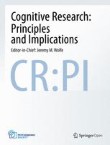Cognitive Research: Principles and Implications is affiliated with The Psychonomic Society
When less is not more: the effect of transparent masks on facial attractiveness judgment
During the COVID-19 pandemic, face masks have been widely used in daily life. Previous studies have suggested that faces wearing typical masks that occlude the lower half of the face are perceived as more attr...
